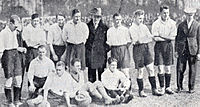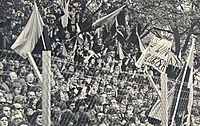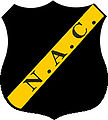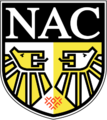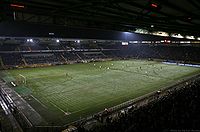- NAC Breda
-
NAC Breda 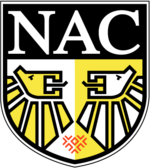
Full name NOAD ADVENDO Combinatie
BredaNickname(s) Pearl of the South
Yellow Army
The RatsFounded September 19, 1912 Ground Rat Verlegh Stadion
(Capacity: 19,000)Chairman  Bas van Bavel
Bas van BavelManager
 John Karelse
John KarelseLeague Eredivisie 2010–11 Eredivisie, 13th Website Club home page Home coloursAway coloursNAC Breda (Dutch pronunciation: [ˈnɑk ˈbreːdɐ]), simply often known as NAC, is a Dutch professional football club, based in Breda, Netherlands. NAC Breda play in the Rat Verlegh Stadium, named after their most important player, Antoon 'Rat' Verlegh. They play in the Dutch Eredivisie and are known by the fierce and fanatic support of their fans. In their history, NAC won one national title in 1921 and won one Cup in 1973.
NAC was founded on September 19, 1912, when the two clubs ADVENDO and NOAD merged to one club. NOAD is a Dutch abbreviation for Nooit Ophouden, Altijd Doorgaan (Dutch pronunciation: [ˈnoːi̯t ˈɔpˌɦʌu̯də(n) ˈɑɫˌtɛi̯t ˈdʊːrˌɣaːn], English: never give up, always persevere), while ADVENDO is a Dutch abbreviation for Aangenaam Door Vermaak En Nuttig Door Ontspanning (Dutch pronunciation: [ˈaːŋɣəˌnaːm ˈdʊːr vərˈmaːk ɛn ˈnʏtəx ˈdʊːr ɔntˈspɑnɪŋ], English: Pleasant for its entertainment and useful for its relaxation), the C stands for Combinatie (combination). The full name of NAC Breda expands to Nooit opgeven altijd doorgaan, Aangenaam door vermaak en nuttig door ontspanning, Combinatie Breda (Dutch pronunciation: [ˈnoːi̯t ˈɔpˌɣeːvə(n) ˈɑɫˌtɛi̯t ˈdʊːrˌɣaːn ˈaːŋɣəˌnaːm ˈdʊːr vərˈmaːk ɛn ˈnʏtəx ˈdʊːr ɔntˈspɑnɪŋ kɔmbɪˈnaː(t)si ˈbreːdɐ]), the longest football club name in the world.[1] Early 2003 NAC added, as a symbol of gratitude, Breda to their club name, after the City of Breda bought NAC’s Rat Verleghstadium to help the club to cope with financial problems.
The last 6 years, NAC played 4 semi-finals in the Dutch Cup tournament, which were all lost. In the season 2007/2008 NAC ended 3rd in the Eredivisie. In season 2008/2009 NAC qualified for the 2nd phase in the UEFA Euro League 2009/2010, but was defeated in the 4th round NAC by Villarreal CF. At the end of season 2009/2010 it appeared, despite earlier denials by management and the chairman, that NAC had a debt of 3.2 million Euros. The crisis lead to the resignation of several board members and the installation of a new board and the appointment of Ed Busselaar as interim managing director. In 2011 it appeared that NAC had a debt of 7.1 million Euros.[2]
Contents
History
Foundation
NAC Breda was founded on September 19, 1912, when the two clubs ADVENDO (Aangenaam Door Vermaak En Nuttig Door Ontspanning (English: Pleasant for its entertainment and useful for its relaxation)) and NOAD (Nooit Opgeven, Altijd Doorzetten (English: never give up, always persevere)) merged to one club. During the new club’s foundation meeting the atmosphere became tense, since NOAD wanted to name the new club NOAD (NOad and ADvendo). This name was for ADVENDO no option. Eventually, Frans Konert proposed to call the club NAC (NOAD ADVENDO Combinatie), which was accepted by the meeting’s attendants.[3] At first, the NVB refused NAC to play associated football, but allowed NAC on October 28, 1912 to play in the 2nd Southern Division.
NAC’s golden ages
The first years weren’t that well for NAC, but when NAC moved to a new stadium ‘t Ploegske the results improved. NAC became one of the topteams in the highest Southern Division. In 1919 NAC became champion of this competition and was allowed to play the Dutch Champions’ Competition (a small competition in which the champions from the regional divisions would play for the Dutch title). During this competition NAC finished on the last place. In 1920, NAC was one of the first clubs to play international matches.[3] NAC played a couple of friendly matches, including a match against Real Madrid CF. NAC won this match with 0–4 and the Spanish newspapers called NAC ‘Los muchacos del Breda, maestros del futbol’ (English: The boys from Breda, masters in football).[4] In 1921 NAC celebrated one of its greatest achievements, when they became Dutch football champion. In the Dutch Championship competition, NAC defeated Ajax, Be Quick 1887 and Go Ahead. NAC continued to play soccer on a high level and in the twenties and thirties NAC was considered to be one of the best clubs in Dutch football. During this period NAC won 6 Southern Division titles and the football was deemed technically perfect by press and public.[3]
Because of this view, the NAC board decided to hire a professional trainer. Englishman Ben Affleck was hired as a coach and was a couple of months later succeeded by James Moore. When Moore resigned, the NAC board issued a committee, who would select the best 11 NAC players to play a match.[5] In 1931 Antoon Verlegh retired from football. Verlegh, nowadays a club icon for NAC, played for NAC since its foundation. In this year, NAC also had a dispute with the City of Breda. The stadium’s terrain ‘t Ploegske was zoned as a residential area and NAC had to leave these grounds. Because no other option was available in Breda, NAC were forced to move to the town Princenhage. Within two months a complete new stadium, with a capacity of 5,500 people, was built and NAC left Breda. In 1935 NAC was also the first club in the Netherlands to travel by airplane to an away match against GVAV.
In 1939 NAC and the City of Breda reopened discussions whether NAC could return to Breda. The city’s council zoned a large piece of land at the Beatrixstraat as stadium area and NAC returned to Breda in 1940. Because of the breakout of the Second World War, NAC decided to play an important social function in Breda’s community. In order to divert the people’s attention from war, NAC organized sport events, theatre, fairs and horsing games. Although NAC remained to play football, several players were employed by the Germans in Germany. During the second World War, youngster Kees Rijvers made his debut for NAC.
Challenging times
After the Second World War, NAC played on the highest level. In 1949 Chairman of Honour C.J. Asselbergs died. Asselbergs was one of the people who were present at NAC since NAC got founded. In 1954 professional football was introduced in the Netherlands. The running competitions were postponed and new competitions were created. NAC entered the 1A League and became champions of this league in 1955. In the championship competition NAC finished second place, behind their rivals Willem II Tilburg.
On March 14, 1960 Breda was shocked to hear the death of Antoon ‘De Rat’ Verlegh. Verlegh, considered to be one of the important persons in Dutch football, died in a car accident on March 12. From NAC’s foundation in 1912, Verlegh was involved in the club at numerous positions and played an important role with the Royal Dutch Football Association. In November 1961 NAC lost another important person; Chairman Jacques Piederiet died. A year later, in August 1962, chairman Le Fevre died. The beginning of the sixties were not bright for NAC. In 1964–1965 NAC even relegated for the first time in its existence.
The relegation meant a total reconstruction of the club’s management. The board resigned and NAC’s intention was to return to the highest level within one year. NAC was successful in this and a season later NAC played on the highest level and a year later qualified for the KNVB Cup’s final, were it lost to AFC Ajax. Although NAC lost, the club was allowed to play UEFA Cup. In the UEFA Cup NAC reached the second round, after defeating Floriana FC. In the second round NAC was knocked out by Cardiff City. Although NAC remained on the highest football level in the Netherlands, NAC were in a heavy struggle not to relegate. May 31, 1973 is another highlight in NAC’s history. In the KNVB Cup’s final, NAC had to play NEC Nijmegen. NAC won the Cup Final, in front of 25,000 people from Breda, with 0–2. Because of this victory, NAC was allowed to play in the UEFA Cup Winners' Cup. In the first round NAC was knocked out by later winners 1. FC Magdeburg.
The birth of the Avondje NAC
In 1975 the NAC board decided to play the home matches on a Saturday evening. In this period a group of fanatic NAC fans merged and located themselves on a stand. Their fierce support lead to an attraction of youngsters, who also fanatically support NAC. This fierce support lasts till now and is known in the Netherlands as an Avondje NAC (English; An Evening NAC). An Avondje NAC is a flamboyant mix of Burgundian fun, beer, fanaticism and love for the club and ensures that during home matches the atmosphere in the stadium is intimidating. On October 6, 1979, a strange situation occurred. During the home match against NAC’s rivals Feyenoord the linesman was hit by an ashtray. The referee postponed the match, riots broke out and the incident in the Netherlands is known as the ‘Ashtray Incident’.
In the eighties NAC relegated two times. After the second relegation, it appeared the financial situation of NAC was terrible. NAC was almost bankrupt and had to sell its belongings to survive. For years NAC struggled to survive, but at the end of the eighties NAC’s situation improved and the club began to play in the top of the Eerste Divisie. On June 7, 1989, NAC player Andro Knel died in a plane accident. It was a shock to the club, especially since Knel was one of the popular players. Hundreds of fans of both NAC Breda and Sparta Rotterdam, Knel’s former club, came together in memorial of Knel. A temporary Knel monument was revealed and the numbers of supporters visiting the monument proved his popularity. Due to the sad moments of Knel's death a special relationship between fans of NAC and Sparta was created.
After Knel’s death, NAC had to continue to play in de Eerste Divisie and three times NAC was close to promote back to the Eredivisie. In 1992, NAC finally promoted to the Eredivisie. With a team managed by Ronald Spelbos and players like John Lammers, Pierre van Hooijdonk, Ton Lokhoff, Fabian Wilnis and John Karelse, NAC played their promotion match in Den Bosch against FC Den Bosch in front of 9,000 NAC fans. The promotion meant a revival of NAC’s popularity, the stadium was sold out and NAC was supported by thousands of people in away matches. In the away match against their rivals Feyenoord in Rotterdam, NAC was supported by 8,000 people. Due to the popularity, the NAC board announced it would leave the stadium at the Beatrixstraat and it would build a new stadium. Until the movement, NAC continued to play on the highest level, missed qualification for the UEFA Cup several times and reached the semi-finals of the KNVB Cup.
A new stadium and continuing financial problems
In 1996 NAC moved to the new stadium, called the FUJIFILM Stadium. With this movement NAC indicated it wanted to play UEFA Cup every year. In 1998 NAC youngster Dominique Diroux died because of an heart attack during the match of the 2nd teams of NAC and AZ. NAC and the new players couldn’t meet the high expectations for a couple of seasons and NAC even relegated in 1999. After this relegation, it appeared that NAC’s financial situation was bad. In 4 seasons, NAC bought 60 players and the costs of the stadium exceeded the budget. In order to save the club, the stadium was bought from NAC by investors and Roelant Oltmans was appointed as the first professional manager at NAC. Also a fans’ council, the first in the Netherlands, was established, in which fans have an advisory role, that protects NAC's culture and defend the fans' interests. NAC also has one position available for a fan in the board of chairmen.
NAC professionalized and promoted in 2000 to the Eredivisie. In 2003 NAC qualified for the UEFA Cup, in which NAC played two matches against Newcastle United. An estimated 4,300 NAC fans travelled to Newcastle to support their team. In 2003 it appeared NAC was again nearing bankruptcy and the City of Breda purchased the stadium again from NAC on January 30, 2003. As a gratitude, NAC changed their name to NAC Breda. After this rescue, the management and the Board of Chairmen resigned and was succeeded by Theo Mommers as managing director and a new Board of Chairmen, led by Willem van der Hoeven. In 2006 NAC decided to rename the stadium to Rat Verlegh Stadion.
For a long time, NAC’s financial position seemed stable and the club finished third in season 2007–2008. In 2009, NAC qualified for the UEFA Europa League. In the 4th round, NAC was defeated by Villarreal CF with 1–3 (home) and 6–1 (away). Despite earlier denials towards fans and stakeholders by management and the Board of Chairmen, it appeared at the end of season 2009-2010 that NAC’s financial position wasn’t stable. The club lost 3.2 million Euro’s that season, due to rebuilding the stadium and buying too expensive players. Board members Willem van der Hoeven, Jacques Visschers and Bas Koomans resigned and Bas van Bavel became new chairman.[6] Managing director Theo Mommers reported ill in April 2010.[7] Bernard Ouwerkerk was appointed in June 2010 as interim managing director of NAC Breda, while Technical Manager Earnest Stewart signed a contract at AZ and was replaced by Jeffrey van As. During this period, NAC manager Maaskant raised his concerns several via the press.[8][9] Because of the financial problems, NAC had to cut budget and Maaskant wasn’t able to buy new players. On August 21, 2010 NAC and Maaskant made public that the trainer would leave NAC Breda for Polish football club Wisła Kraków, where Maaskant signed a 2-year deal.[10] His assistant managers John Karelse, Gert Aandewiel and Arno van Zwam became the interim managers for NAC Breda. In January 2011 Bernard Ouwerkerk resigned and was succeeded by Ed Busselaar. In March 2011 it appeared that NAC had a debt of 7.1 million Euros.
Honours
- Eredivisie [11]
- Winners (1): 1921
- KNVB Cup [11]
- Winners (1): 1973
- Eerste Divisie [11]
- Winners (1): 2000
- Eerste Klasse [11]
- Winners (9): 1919, 1921, 1922, 1924, 1925, 1927, 1936, 1946, 1955
Domestic Results
Below is a table with NAC Breda's domestic results since the introduction of the Eredivisie in 1956.
Domestic Results since 1956 Domestic league League result Qualification to KNVB Cup season Cup result 2010–11 Eredivisie 13th - 2010-11 quarter final 2009–10 Eredivisie 10th - 2009-10 quarter final 2008–09 Eredivisie 8th Europa League (winning EL play-offs) (Q2) 2008-09 semi-final 2007–08 Eredivisie 3rd Intertoto Cup (losing CL play-offs) 2007-08 semi-final 2006–07 Eredivisie 11th - (losing IC play-offs) 2006-07 semi-final 2005–06 Eredivisie 16th - (surviving promotion/relegation play-offs) 2005-06 third round 2004–05 Eredivisie 15th - 2004-05 quarter final 2003–04 Eredivisie 9th - 2003-04 semi-final 2002–03 Eredivisie 4th UEFA Cup 2002-03 round of 16 2001–02 Eredivisie 6th Intertoto Cup (R3) 2001-02 second round 2000–01 Eredivisie 9th - 2000-01 second round 1999–2000 Eredivisie 1st Eredivisie (promotion) 1999-2000 second round 1998–99 Eredivisie 18th Eerste Divisie (relegation) 1998-99 round of 16 1997–98 Eredivisie 12th - 1997-98 quarter final 1996–97 Eredivisie 9th - 1996-97 second round 1995–96 Eredivisie 8th - 1995-96 round of 16 1994–95 Eredivisie 10th - 1994-95 quarter final 1993–94 Eredivisie 7th - 1993-94 semi-final 1992–93 Eerste Divisie 3rd Eredivisie (winning promotion/releg. play-offs) 1992-93 second round 1991–92 Eerste Divisie 4th promotion/relegation play-offs: no promotion 1991-92 third round 1990–91 Eerste Divisie 2nd promotion/relegation play-offs: no promotion 1990-91 round of 16 1989–90 Eerste Divisie 2nd promotion/relegation play-offs: no promotion 1989-90 second round 1988–89 Eerste Divisie 7th - 1988-89 first round 1987–88 Eerste Divisie 17th - 1987-88 first round 1986–87 Eerste Divisie 8th - 1986-87 first round 1985–86 Eerste Divisie 13th - 1985-86 round of 16 1984–85 Eredivisie 17th Eerste Divisie (relegation) 1984-85 round of 16 1983–84 Eerste Divisie 3rd Eredivisie (winning promotion/releg. play-offs) 1983-84 second round 1982–83 Eredivisie 17th Eerste Divisie (relegation) 1982-83 second round 1981–82 Eredivisie 11th - 1981-82 round of 16 1980–81 Eredivisie 13th - 1980-81 second round 1979–80 Eredivisie 16th - 1979-80 second round 1978–79 Eredivisie 10th - 1978-79 quarter final 1977–78 Eredivisie 11th - 1977-78 second round 1976–77 Eredivisie 8th - 1976-77 quarter final 1975–76 Eredivisie 11th - 1975-76 second round 1974–75 Eredivisie 16th - 1974-75 second round 1973–74 Eredivisie 16th - 1973-74 final 1972–73 Eredivisie 16th Cup Winners' Cup 1972-73 winners 1971–72 Eredivisie 13th - 1971-72 round of 16 1970–71 Eredivisie 14th - 1970-71 first round 1969–70 Eredivisie 10th - 1969-70 second round[citation needed] 1968–69 Eredivisie 7th - 1968-69 second round[citation needed] 1967–68 Eredivisie 15th - 1967-68 group stage[citation needed] 1966–67 Eredivisie 12th - 1966-67 final 1965–66 Eerste Divisie 3rd Eredivisie (promotion) 1965-66 quarter final[citation needed] 1964–65 Eredivisie 16th Eerste Divisie (relegation) 1964-65 semi-final[citation needed] 1963–64 Eredivisie 6th - 1963-64 second round[citation needed] 1962–63 Eredivisie 6th - 1962-63 third round[citation needed] 1961–62 Eredivisie 5th - 1961-62 ?[citation needed] 1960–61 Eredivisie 9th - 1960-61 final 1959–60 Eredivisie 5th - not held not held 1958–59 Eredivisie 11th - 1958-59 ?[citation needed] 1957–58 Eredivisie 8th - 1957-58 ?[citation needed] 1956–57 Eredivisie 9th - 1956-57 ?[citation needed] Colours and crest
Colours
NAC’s official colours are yellow, white and black. During their existence these colours have always been in NAC’s home and/or away kit.[3]
Initially, NAC’s home kit was a black shirt -with a diagonal yellow line-, a white short and yellow black socks. In 1916 NAC changed this kit towards a white shirt. This white shirt would remain till the sixties, when NAC decided to replaced the white shirt with a yellow shirt and black shorts [3] Conversely, NAC’s away colours have been very inconsistent. There is no setting in the colour standards. In NAC cultural manifest it has been stated that the home and away kits should have the official NAC colours.[12] Afterwards, NAC announced to play their home matches in a yellow shirt, with a black diagonal line running over it, black shorts and white socks, with some yellow accents in it. The away kit is a white shirt, with a yellow diagonal line marked by a black border running over it. White short and white socks complete the away kit.
Crest
During their existence, NAC had 4 different crests. After their foundation in 1912, their crest was a black shield, with a yellow diagonal line running over it and in it the letters N.A.C.. This crest was replaced in 1968 by another crest. The reason for this crest change is unknown. In 1974 the crest was replaced by a crest which contained the letters NAC in a black and yellow combination. The crest was most probably changed due to the dismissal of the NAC board in 1974. In order to state a new beginning, a new board member’s daughter designed NAC’s third crest.[13] The current crest consists of two lions, three crosses, the letters NAC and it contains NAC’s official club colours. The two lions and the three crosses are derived from Breda’s crest. The current crest was developed in 1996, when NAC moved to the Rat Verlegh Stadion.
Stadiums
BLO Terrein
Period: 19 September 1912 – 31 July 1913. Directly after the merger of NOAD and ADVENDO, and thus the foundation of NAC, the board rented the fields of the Bond voor Lichaamlijke Opvoeding to play their homematches. The terrain, located east of the Wilhelmina Park in Breda, was NAC’s homeground for one season. Because of the terrain’s poor conditions, NAC moved to another terrain.
Achter de Watertoren
Main article: Terrein achter de WatertorenPeriod: 1 August 1913 – 31 July 1916. For three seasons NAC played at the grounds known as Achter de Watertoren (English: Behind the watertower), located north of the Wilhelmina Park in Breda. During the seasons NAC played at Achter de Watertoren, NAC’s popularity increased and the club decided to move for the third time in her existence.
‘t Ploegske
Main article: NAC Stadion t PloegskePeriod: 1 August 1916 – 29 August 1931. Without no doubt, NAC’s biggest successes were at the stadium ‘t Ploegske. In 1921 NAC celebrated the Dutch championship at the stadium. ‘t Ploegske was the first NAC stadium with stands, and a capacity over 3,000, was located at the Molengracht in Breda. Due to the fact Breda’s City Council zoned the area as a residential area, NAC were forced to move.
Heuvelstraat
Main article: NAC stadion HeuvelstraatPeriod: 30 August 1931 – 1 August 1940. Due to the City Council’s decision to zone the grounds of ‘t Ploegske as a residential area and the city of Breda had no new grounds available, NAC were forced to move out Breda. The town of Princenhage offered NAC a terrain, where NAC built a state-of-the-art stadium with a capacity of 5,500. The main disadvantage was that the stadium was located far from Breda’s city centre. Nevertheless, NAC’s golden decennium in the thirties, when NAC was considered to be one of the top clubs in the Netherlands, took place in the stadium at the Heuvelstraat. In 1939 the city of Breda offered NAC a new terrain at the Beatrixstraat.
Beatrixstraat
Main article: NAC StadionPeriod: 1 August 1940 – 13 May 1996. Moving to the Beatrixstraat meant a return to NAC’s roots. NAC was back in the city where it belonged. NAC’s popularity increased and in the fifties and sixties NAC was considered to be one the biggest clubs in the Netherlands. In the seventies NAC became notorious for their evening matches at this stadium. An intimidating and fierce atmosphere lead to the birth of the ‘Avondje NAC’ (English: Evening NAC), in which NAC’s fans fanatically supported their team. The stadium’s top capacity was 18,500. Due to strict regulations, it was limited to 12,560 in the nineties. Due to the stadium’s age and overdue maintenance, NAC left the stadium in 1996.
Rat Verlegh stadium
Main article: Rat Verlegh StadionPeriod: 11 August 1996 – Present. NAC’s current ground is the Rat Verlegh stadium, located 2 kilometres north west of Breda’s city centre. Founded as the FUJIFILM Stadium, the name was changed in 2003 to the MyCom stadium. From the stadium’s opening the NAC fans used the name Rat Verlegh stadium, which was officially assigned by NAC to the stadium in 2006. At present, the stadium’s capacity is 17,750. Due to the increasing popularity of NAC Breda, the stadium was expanded in summer 2010 to a capicity of 19,000.[14]
Fans
NAC fans often refer to themselves as ‘The Rats’ or ‘The Yellow Army’. NAC Breda have a loyal fanbase, with virtually all their home matches selling out. National and international NAC is known by the fierce and fanatic support of their fans, combined in the term ‘Avondje NAC’ (English: ‘An evening NAC’). A flamboyant mix of Burgundian fun, beer, fanaticism and love for the club ensures that during home matches the atmosphere in the stadium is intimidating. The term has its roots in the seventies, when the board decided to play their home matches at a Saturday evening. Nowadays, NAC is supported by two fanatic sides: The B-Side and Vak G. The club’s fans also publish NAC Fanzine De Rat, named after Antoon ‘Rat’ Verlegh. NAC was the first club in Dutch professional soccer to found a fans' council. This council is an advisary organisation, that protects NAC's culture and defend the fans' interests. NAC also has one position available for a fan in the board of chairmans.
Rivalries
NAC Breda’s longest-running and deepest rivalry is with their nearest neighbour, Willem II from Tilburg, colloquially known as Stillem II (English: Quietness II). This rivalry originated in the twenties of the 20th century. Matches between the two are referred to as the derby of Brabant. The two cities of Breda and Tilburg are just 20 kilometres apart, leading to an intense feeling of a cross-town rivalry, heightened by a feeling that it is city against city with local pride at stake.
NAC Breda’s other deep running rivalry is with Rotterdam based club Feyenoord. The rivalry has its roots after several incidents between fans of both clubs in the seventies of the 20th century. Although Feyenoord fans don’t have the same rival feelings like NAC fans have, matches against Feyenoord are considered to be of the most important and most violent matches of a season.
Organisation NAC Breda
NAC Breda's mission and vision
NAC Breda's current management defined NAC Breda's mission and vision as [15]:
NAC Breda plays professional football at the highest level in the Netherlands. NAC is a club of the people, with deep roots in Breda. Our football is cheeky, brave, opportunistic, passionate, proud and full of team spirit. NAC is the heart of social cohesion between all sections in society.
NAC Breda's core values
NAC Breda's current management defined, together with NAC fans, several core values, which are the fundaments of NAC Breda's identity.[16] These core values are:
- Affectionate : Being creative, original and cocky;
- Burgundy style : The good side of life, passionate, enjoyment, emotional;
- Cohesive : Nobody excluded, aimed at people, strong bonds;
- Self conscious : Own background and history, proud, authentic, roots in Breda.
NAC Breda's policy
In NAC Breda's policy, put in place by NAC Breda's current management, several objectives have been named by NAC's management [15]:
- In 2012, NAC Breda belongs to the best 9 clubs in the Eredivisie;
- In 2012, NAC Breda has the best youth academy in the south-western area of the Netherlands;
- NAC Breda will become the important leisure activity for fans. NAC aims to welcome 20,000 fans per match;
- NAC Breda will become the biggest business platform in the south-western area of the Netherlands;
- NAC Breda's operating budget will rise to at least 17 million Euro. Every year profits will be made and investments will be done by own merits.
NAC Breda in the community
In NAC’s mission and vision, the club acknowledges that it has an important impact on the local community. With social projects like the NAC Streetleague (a football tournament between several districts from Breda), Teamplay @ NAC (project aimed at disadvantaged youth), reintegration projects and the Young Yellows, NAC has a positive influence in the Breda community.
NAC Breda's supervisory board
NAC Breda's supervisory board consists of 7 people.[17]
NAME ROLE  prof. dr. B.J.P. (Bas) van Bavel
prof. dr. B.J.P. (Bas) van BavelChairman  A.J.J.M. Lips
A.J.J.M. Lips E.J.F. (Arie) Verbakel RA
E.J.F. (Arie) Verbakel RA mr. C.J.M. Gielen
mr. C.J.M. Gielen C.P.A. van Haperen
C.P.A. van HaperenNAC Breda's management
NAC Breda's management consists of the following people.[17]
NAME ROLE  Bernard Ouwerkerk
Bernard OuwerkerkInterim Managing Director  Jeffrey van As
Jeffrey van AsInterim Technical Manager  Willem Reijn
Willem ReijnInterim Financial Manager Main squad
As of 1 August 2011
For recent transfers, see List of Dutch football transfers summer 2011
Note: Flags indicate national team as has been defined under FIFA eligibility rules. Players may hold more than one non-FIFA nationality.
No. Position Player 1 
GK Jelle ten Rouwelaar (captain) 2 
DF Milano Koenders (on loan from AZ) 3 
DF Eric Botteghin 4 
MF Roly Bonevacia (on loan from Ajax) 5 
MF Mike Zonneveld 6 
MF Tim Gilissen 7 
DF Kees Luijckx 8 
MF Robbert Schilder 9 
FW Santi Kolk (on loan from Union Berlin) 10 
FW Anthony Lurling 11 
FW Florian Jozefzoon (on loan from Ajax) No. Position Player 12 
DF Jens Janse 15 
FW Alex Schalk 16 
GK Jim van Fessem 17 
FW Mats Seuntjens 18 
DF Donny Gorter 19 
FW Ömer Bayram 20 
DF Nemanja Gudelj 23 
DF Jordy Buijs 24 
MF Pim Bouwman 32 
MF Andreas Lasnik On loan
Note: Flags indicate national team as has been defined under FIFA eligibility rules. Players may hold more than one non-FIFA nationality.
No. Position Player 30 
FW Leonardo (to Red Bull Salzburg) Former players and managers
Former Dutch international Pierre van Hooijdonk is a former NAC player and a NAC fan. Other NAC players who were Dutch internationals, are
 Frans Bouwmeester
Frans Bouwmeester Ad Brouwers
Ad Brouwers Leo Canjels
Leo Canjels Kees Kuijs
Kees Kuijs Ton Lokhoff
Ton Lokhoff Bertus Quaars
Bertus Quaars
 Nico Rijnders
Nico Rijnders Kees Rijvers
Kees Rijvers Daan Schrijvers
Daan Schrijvers Antoon ‘De Rat’ Verlegh
Antoon ‘De Rat’ Verlegh Martien Vreijsen
Martien Vreijsen
Foreigners
 Glen Salmon
Glen Salmon Johan Elmander
Johan Elmander Johan Vonlanthen
Johan Vonlanthen Earnest Stewart
Earnest Stewart Igor Korneev
Igor Korneev Joonas Kolkka
Joonas Kolkka Jung Yoon Noh
Jung Yoon Noh Matthew Amoah
Matthew Amoah
Topscorers
SEASON PLAYER'S NAME GOALS DIVISION NAC'S RANK NAC'S POINTS 1990-91  Ton Cornelissen
Ton Cornelissen36 Eerste Divisie 2nd 38–56 (94–50) 1991-92  John Lammers
John Lammers29 Eerste Divisie 4th 38–44 (65–48) 1992-93  Pierre van Hooijdonk
Pierre van Hooijdonk29 Eerste Divisie 3rd 34–45 (73–39) 1993-94  Pierre van Hooijdonk
Pierre van Hooijdonk25 Eredivisie 7th 34–38 (61–52) 1994-95  Pierre van Hooijdonk /
Pierre van Hooijdonk /
 Graham Arnold
Graham Arnold10 Eredivisie 10th 34–29 (54–60) 1995-96  Graham Arnold
Graham Arnold16 Eredivisie 8th 34–52 (58–44) 1996-97  Graham Arnold /
Graham Arnold /
 Earnest Stewart
Earnest Stewart9 Eredivisie 9th 34–40 (41–54) 1997-98  Archil Arveladze
Archil Arveladze11 Eredivisie 12th 34–42 (41–49) 1998-99  Archil Arveladze
Archil Arveladze10 Eredivisie 18th 34–23 (41–61) 1999-00  Archil Arveladze
Archil Arveladze21 Eerste Divisie 1st 34–82 (84–36) 2000-01  Earnest Stewart
Earnest Stewart8 Eredivisie 9th 34–49 (41–40) 2001-02  Earnest Stewart /
Earnest Stewart /
 Cristiano
Cristiano10 Eredivisie 6th 34–54 (55–52) 2002-03  Orlando Engelaar
Orlando Engelaar11 Eredivisie 4th 34–52 (42–31) 2003-04  Orlando Engelaar
Orlando Engelaar9 Eredivisie 9th 34–46 (58–55) 2004-05  Ali Boussaboun
Ali Boussaboun13 Eredivisie 15th 34–35 (43–67) 2005-06  Leonardo
Leonardo8 Eredivisie 16th 34–33 (45–66) 2006-07  Glen Salmon
Glen Salmon8 Eredivisie 11th 34–43 (43–54) 2007-08  Matthew Amoah
Matthew Amoah11 Eredivisie 2nd 34–63 (48–40) 2008-09  Matthew Amoah
Matthew Amoah12 Eredivisie 8th 34–45 (44–54) 2008-09  Matthew Amoah
Matthew Amoah9 Eredivisie 10th 34–46 (42–49) NAC Breda managers
Period Manager Period Manager Period Manager Jun 1926 – Oct 26  Ben Affleck
Ben AffleckJul 1968 – Jun 71  Leo Canjels
Leo CanjelsJul 1992 – Dec 92  Piet de Visser
Piet de VisserFeb 1927 – Apr 28  James Moore
James MooreJul 1971 – Mar 73  Ben Peeters
Ben PeetersJan 1993 – Jun 95  Ronald Spelbos
Ronald SpelbosJul 1934 – Jun 41  Lou van der Linden
Lou van der LindenMar 1973 – Jun 75  Henk Wullems
Henk WullemsJul 1995 – Jun 97  Wim Rijsbergen
Wim RijsbergenJul 1934 – Jun 44  Cor Kools
Cor KoolsJul 1975 – Jun 77  Bob Maaskant
Bob MaaskantJun 1997 – Oct 98  Herbert Neumann
Herbert NeumannJul 1934 – Jun 45  Antoon Verlegh
Antoon VerleghJul 1977 – Jan 79  Hans Dorjee
Hans DorjeeOct 1998 – Mar 99  Ronald Spelbos
Ronald SpelbosJul 1942 – Jun 47  Jan Blom
Jan BlomJan 1979 – Jun 83  Jo Jansen
Jo JansenMar 1999 – Jun 00  Kees Zwamborn
Kees ZwambornJul 1945 – Jun 47  Cor Kools
Cor KoolsJul 1983 – Mar 84  Henk de Jonge
Henk de JongeJul 2000 – Jun 03  Henk ten Cate
Henk ten CateJul 1945 – Jun 47  Cor Kools
Cor KoolsMar 1984 – Jun 86  Bob Maaskant
Bob MaaskantJul 2003 – Dec 05  Ton Lokhoff
Ton LokhoffJul 1947 – Jun 49  Joseph Veréb
Joseph VerébJul 1986 – Jun 87  Leen Looyen
Leen LooyenJan 2006 – Apr 06  Cees Lok
Cees LokJul 1949 – Jun 61  Cor Kools
Cor KoolsJul 1987 – Mar 90  Hans Verèl
Hans VerèlApr 2006 – Jun 06  John Karelse
John KarelseJul 1949 – Jun 61  Jan Blom
Jan BlomMar 1990 – Apr 90  Ton Carton
Ton CartonJul 2006 – Jun 08  Ernie Brandts
Ernie BrandtsJul 1961 – Jul 66  Simon Plooijer
Simon PlooijerApr 1990 – Oct 91  Cor Pot
Cor PotJul 2008 – Aug 2010  Robert Maaskant
Robert MaaskantJul 1966 – Jun 68  Bob Janse
Bob JanseOct 1991 – Jun 92  Jo Jansen
Jo JansenAug 2010 – present  John Karelse
John Karelse
 Gert Aandewiel
Gert Aandewiel
 Arno van Zwam
Arno van ZwamSee also
References
- ^ http://football.guardian.co.uk/theknowledge/story/0,,1666197,00.html Guardian's article about longest clubname
- ^ http://www.bredablog.com/nac/?p=1871 Article BN/De Stem
- ^ a b c d e John de Leeuw & Rob Lemmens, ‘80 Jaar NAC’ (1992)
- ^ http://www.home.zonnet.nl/jjdewit/real-nac.htm, newsarticle Real Madrid – NAC 0–4
- ^ Andries Schouten, Jules Ots and Adriaan Veraart (1962), ’50 jaar NAC’
- ^ http://www.nac.nl/nieuws/33041/nac-grijpt-in-na-miljoenenverlies.html, Dutch pressrelease NAC Breda about financial problems
- ^ http://www.ad.nl/ad/nl/1001/AD-Sportwereld/article/detail/474088/2010/04/03/NAC-directeur-Mommers-met-ziekteverlof.dhtml, Dutch news article Algemeen Dagblad about Theo Mommer’s illness
- ^ http://www.nacblog.nl/index.php?itemid=3027 Dutch news article Maaskant demands openness NAC board
- ^ http://www.nacblog.nl/index.php?itemid=3028 Dutch news article Maaskant needs to talk to NAC board
- ^ http://www.nac.nl/nieuws/33565/robert-maaskant-onmiddellijk-naar-wisla-krak-w.html Dutch article on transfer Maaskant
- ^ a b c d http://www.derat.nl/int/nl/club/info.asp, Overview history NAC Breda
- ^ http://www.clubraadnac.nl/index.php?option=com_content&task=view&id=20&Itemid=34 NAC’s Cultural Manifest
- ^ John de Leeuw, Official NAC archive, 2009.
- ^ De verbouwing kan beginnen.
- ^ a b http://wwww.nac.nl/pagina2/26792/Beleidsplan.html, NAC Breda's policy, vision and mission
- ^ http://wwww.nac.nl/pagina/26672/Identiteit.html, NAC Breda's identity values
- ^ a b http://wwww.nac.nl/pagina/8495/Organigram.html, NAC Breda's organisation
External links
- NAC.nl – Official website of NAC Breda (Dutch)
- Fanzine The Rat (Dutch)
- B-side Rats (Dutch)
NAC Breda Grounds: BLO terrein · Terrein achter de Watertoren · `t Ploegske · Heuvelstraat · Beatrixstraat · Rat Verlegh StadionEredivisie 2011–12 ADO Den Haag · Ajax · AZ · Excelsior · Feyenoord · De Graafschap · Groningen · Heerenveen · Heracles Almelo · NAC Breda · NEC · PSV · RKC Waalwijk · Roda JC · Twente · Utrecht · Vitesse · VVVFootball League Championship/Eredivisie seasons 1888–89 · 1889–90 · 1890–91 · 1891–92 · 1892–93 · 1893–94 · 1894–95 · 1895–96 · 1896–97 · 1897–98 · 1898–99 · 1899–1900 · 1900–01 · 1901–02 · 1902–03 · 1903–04 · 1904–05 · 1905–06 · 1906–07 · 1907–08 · 1908–09 · 1909–10 · 1910–11 · 1911–12 · 1912–13 · 1913–14 · 1914–15 · 1915–16 · 1916–17 · 1917–18 · 1918–19 · 1919–20 · 1920–21 · 1921–22 · 1922–23 · 1923–24 · 1924–25 · 1925–26 · 1926–27 · 1927–28 · 1928–29 · 1929–30 · 1930–31 · 1931–32 · 1932–33 · 1933–34 · 1934–35 · 1935–36 · 1936–37 · 1937–38 · 1938–39 · 1939–40 · 1940–41 · 1941–42 · 1942–43 · 1943–44 · 1945–46 · 1946–47 · 1947–48 · 1948–49 · 1949–50 · 1950–51 · 1951–52 · 1952–53 · 1953–54 · 1954–55 · 1955–56 · 1956–57 · 1957–58 · 1958–59 · 1959–60 · 1960–61 · 1961–62 · 1962–63 · 1963–64 · 1964–65 · 1965–66 · 1966–67 · 1967–68 · 1968–69 · 1969–70 · 1970–71 · 1971–72 · 1972–73 · 1973–74 · 1974–75 · 1975–76 · 1976–77 · 1977–78 · 1978–79 · 1979–80 · 1980–81 · 1981–82 · 1982–83 · 1983–84 · 1984–85 · 1985–86 · 1986–87 · 1987–88 · 1988–89 · 1989–90 · 1990–91 · 1991–92 · 1992–93 · 1993–94 · 1994–95 · 1995–96 · 1996–97 · 1997–98 · 1998–99 · 1999–2000 · 2000–01 · 2001–02 · 2002–03 · 2003–04 · 2004–05 · 2005–06 · 2006–07 · 2007–08 · 2008–09 · 2009–10 · 2010–11 · 2011–12 - Eredivisie [11]
Wikimedia Foundation. 2010.

